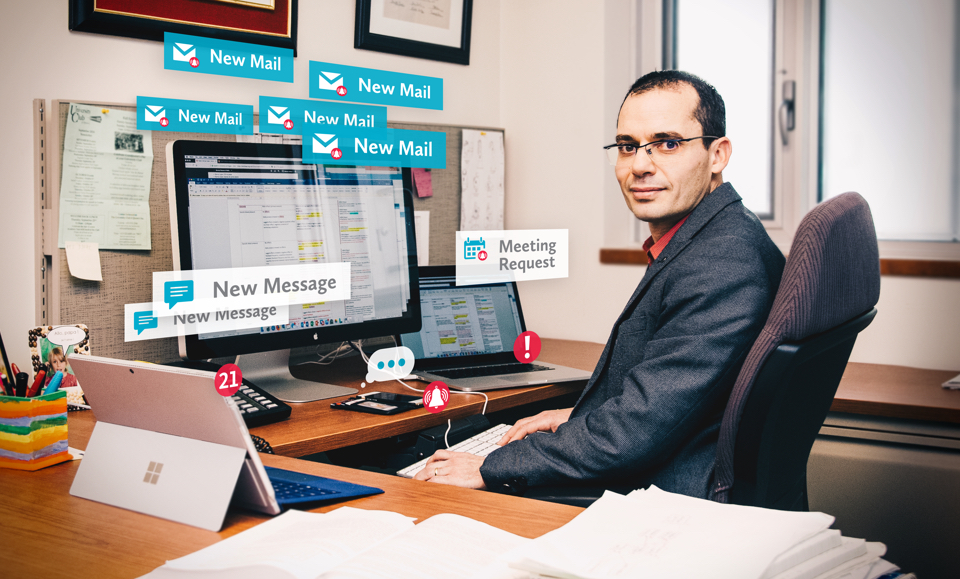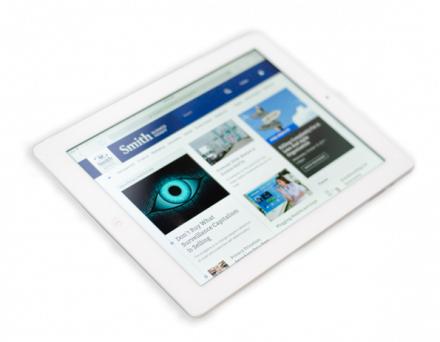Endless Emails...

Chances are, you won’t get to the end of this story without being interrupted by a text message or urgent email that you just have to open. And I’m okay with that; I just checked my email in the middle of writing this paragraph.
According to some studies, we enjoy a measly five minutes of uninterrupted time; once interrupted, half of us won’t get back to what we were doing. Yet it’s hard to resist the urge to check emails or text messages — pressing tasks be damned.
Most of us harbour some shame at our inability to ignore interruptions. Shamel Addas understands your pain but says not all interruptions are necessarily bad. They can even be productive.
“I know from personal experience that some interruptions are actually good,” says Shamel, Assistant Professor of Information Systems at Smith School of Business.
Shamel joined Smith two years ago from the IÉSEG School of Management in Lille, France. His research looks at the consequences — intended and not — of information systems. He’s particularly fascinated by the “dark side” of IS and the effects on job performance.
“Sometimes each interruption in and of itself is not that bad. But the effect can accumulate over time and lead to fatigue and stress.”
Shamel says our understanding of how email interruptions influence work is limited. What we do know is based on lab studies of discrete events that last seconds — which is not how interruptions occur. “What happens in real life is more like a continuous stream of interruptions,” he says. “Sometimes each interruption in and of itself is not that bad. But the effect can accumulate over time and lead to fatigue and stress.”
Inside the black box

What he found was that interruptions not related to primary activities directly undermined a worker’s performance; such interruptions led to increased error rates, poor memory and decreased output quality. Returning to their main jobs and completing their tasks took workers longer when interruptions were unrelated to their work than when interruptions were directly related to it.
Furthermore, interruptions not related to primary work had an indirect effect on performance; they increased stress by making people feel their workload was unmanageable. While interruptions related to workers’ primary activities increased stress levels, too, they actually boosted salespeople’s effectiveness.
Out of sight, out of mind
Shamel also discovered that people who engaged in several email conversations at the same time, or those who let messages pile up in their inbox, experienced higher stress and lower performance than those who did neither. This piling up of messages “creates a constant reminder of all the stuff that needs to be done,” says Shamel. “On the other hand, for those who just deleted emails or filed them into other folders, it was out of sight, out of mind.”
Shamel adds that an overflow of email interruptions can affect group performance as well. Stress that individuals feel, for example, can spill over to colleagues. In a group, if one person is constantly interrupted, others must pick up the slack.
A little quiet time, please
What does Shamel’s research mean for managers? For one thing, just recognizing there are different types of interruptions, each with its own trade-off, can help mitigate stress and negative impact on performance.
Shamel suggests managers develop email-management programs and interventions, such as specifying a time-response window for email messages based on their urgency. Managers could also establish periods of quiet time for uninterrupted work. And they could encourage groups to develop co-ordination strategies to ensure one person’s interruptions do not hinder colleagues.
On the individual level, workers could handle interruptions in batches, rather than in real time, in order to reduce time switching back and forth between tasks and interruptions. Workers could also delete, or organize in folders, messages that are of limited use to their core work.
Shamel sees design implications, too, particularly for context-aware systems and email clients. Context-aware systems know what kinds of tasks people are working on and can detect high- and low-workload periods. Email clients can be programmed to screen messages for those that are relevant to a person’s current job and for those to be dealt with in the future, he says.
After all, even the most disciplined of us need a little help to resist temptation.

